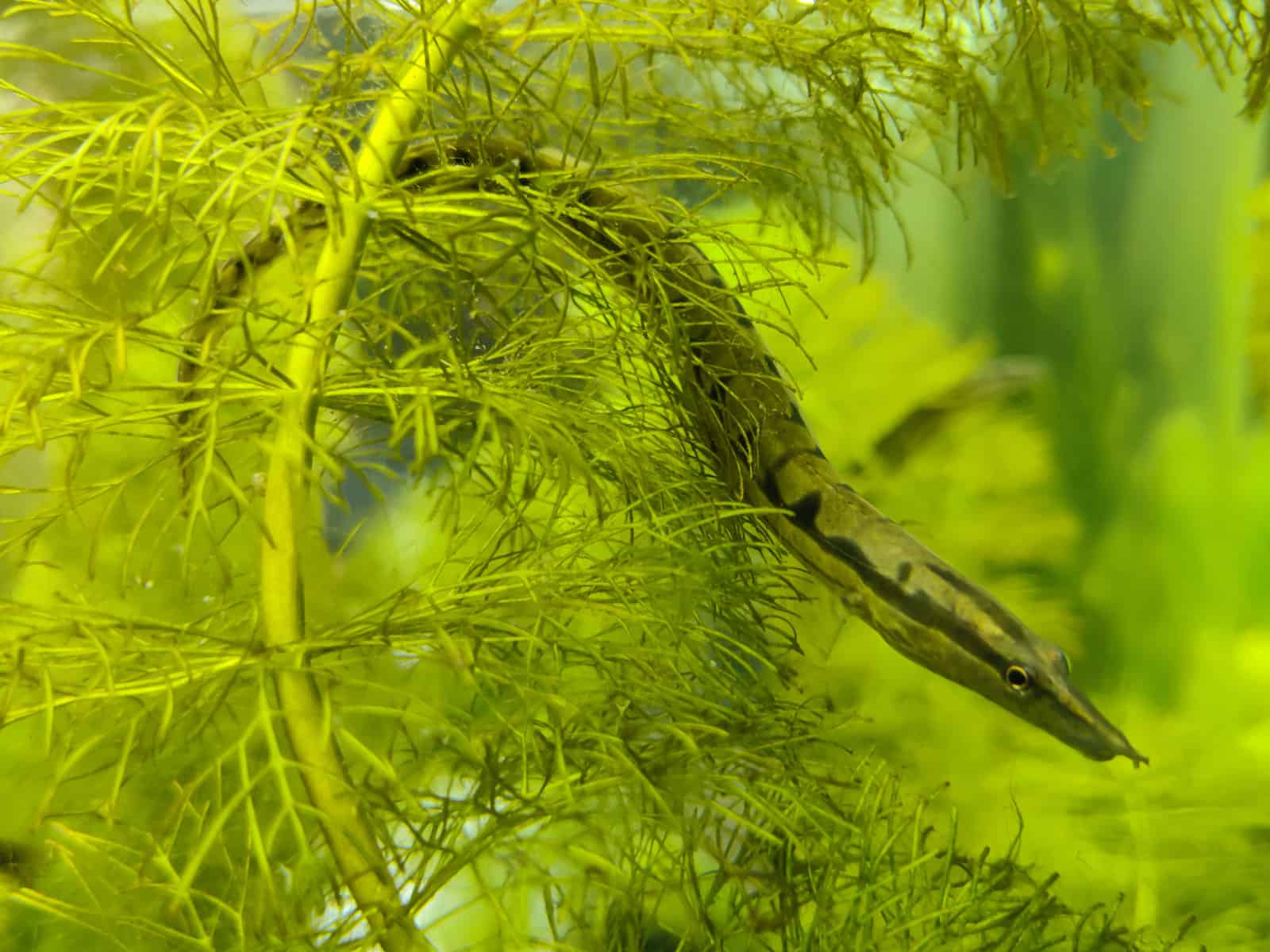If you’re looking for something a little bit different to add to your freshwater fish tank, you might want to consider the unusual, beautiful Tire Track eel.
However, these fascinating, snake-like fish have a reputation for being somewhat challenging to keep, although in my experience that’s not necessarily true.
Read this guide to learn everything you need to know about caring for these fabulous freshwater eels!
Tire Track Eel – At a Glance
| Tire Track Eels Info | |
|---|---|
| Scientific Name | Mastacembelus armatus |
| Common Name | Tire Track Eel, White Spotted Spiny Eel |
| Family | Mastacembelidae |
| Origins | Thailand, Peninsular Malaysia, Lao People’s Democratic Republic, Vietnam, Cambodia |
| Diet | Omnivore |
| Care Level | Intermediate |
| Activity | Active |
| Lifespan | 8 to 18 years |
| Temperament | Semi-aggressive |
| Minimum Tank Size | 75 gallons |
| Temperature Range | Tropical 72° to 82° F |
| Water Hardness | dKH 10 to 16 |
| pH Range | 6.8 to 7.2 |
| Filtration/Flow Rate | Well-oxygenated, medium flow |
| Water type | Freshwater |
| Breeding | Egg-layer |
| OK, for Planted Tanks? | Yes |
Origins
Tire Track eels come from Southeast Asia, specifically Malaysia, Vietnam, Cambodia, and Thailand.
The species is currently listed as being of Least Concern (LC) on the IUCN Red List since these eels are relatively common and widely distributed. However, the main threats to the Tire Track eel are overfishing for the pet trade and pollution.
Natural Habitat
Tire Track els inhabit inland freshwater rivers, streams, and marshes, hiding under rocks or the sandy substrate during daylight hours and emerging at night to hunt and feed.
These fish are mainly carnivorous, feeding on worms, small fish, insect larvae, and invertebrates. However, the eels also eat detritus and some plant matter.
Appearance
Tire Track eels have an elongated body with a long snout. The eel’s background color is light brown to tan, but the creature takes its name from the irregular, dark zig-zag markings running vertically from back to belly.
These eels are often confused with Zig Zag eels, which are a different species and grow considerably larger, often reaching 35 inches long! The two species look very similar as juveniles, so do be sure to check what species you’re taking home before you part with any cash in the fish store!
Male or Female?
It’s almost impossible to differentiate between the sexes, although female Tire Track eels might be somewhat more full-bodied than males.
Tire Track Eel Size
Tire Track eels can grow to a maximum size of around 20 inches in the tank, although wild specimens can get much larger than that.
How Long Does It Take for Tire Track Eels To Grow?
The Tire Track eel’s growth rate varies, depending on the animal’s living conditions, but they tend to be pretty slow growing, averaging only 0.5 to 1 inch per month.
Lifespan
These creatures are quite long-lived, surviving for between 8 and 18 years if given the correct care, environment, and diet.
Are Tire Track Eels Difficult To Keep?
We don’t recommend these fish for beginners, since they can be sensitive to environmental changes and can be very shy at first. For that reason, it can be challenging to persuade the eels to eat for a couple of weeks when you first add them to your tank.
In addition, Tire Track eels have very small scales, leaving them susceptible to fungus, bacteria, and parasites. These fish are highly sensitive to medications, especially those containing copper. However, if fed correctly and given the correct care, you’ll get to enjoy many years of pleasure from keeping Tire Track eels.
Are Tire Track Eels Aggressive?
Although Tire Track eels are semi-aggressive carnivores, they can live relatively well in a community setup.
Compatibility and Tankmates
Tire Track eels are nocturnal and are typically shy and peaceful fish that will ignore their tank mates. That said, these eels are meat-eaters and they will eat any fish or inverts that are small enough to fit into their mouths.
Tire Track Eel Ideal Tank Mates
Although you wouldn’t initially consider these creatures as candidates for a community tank, my Tire Track eels were fine in a tank with larger types of fish that they didn’t view as a food source.
Fish To Avoid
You should avoid keeping Tire Track eels with highly territorial or aggressive fish. In addition, spiny eels will eat very small fish and shrimp, so it’s best to avoid these critters as tank mates.
Can You Keep Tire Track Eels Together?
Some spiny eels can become territorial and quite aggressive with their own kind as they mature, so it’s best to keep just one Tire Track eel unless you intend to attempt a breeding project.
When keeping more than one Tire Track eel, we recommend you have a very large tank with plenty of hiding places, caves, and rocky overhangs that the individuals can claim as their territory.
Feeding
In their wild environment, Tire Track eels are omnivores, eating a varied diet of worms, small fish, crustaceans, invertebrates, and insect larvae, as well as detritus and some plant matter.
In captivity, spiny eels prefer a balanced diet of live foods, including black worms, bloodworms, earthworms, and brine shrimp. However, these eels will also take frozen foods, which makes feeding them somewhat easier.
Tire Track eels won’t usually accept freeze-dried meaty foods, fish flakes, or pellets. However, these creatures do eat detritus, so they might scavenge some leftover fish food from the tank bottom.
How Often Should You Feed Your Tire Track Eel?
Tire Track eels only need to be fed twice a week and often refuse food if fed more frequently than that. Note that if you overfeed your eels, they might stop eating for a couple of weeks or even more.
These eels are nocturnal tropical fish, emerging from hiding at night to feed. So, you should offer them food just before you turn the aquarium lights out.
Tank Requirements
Tire Track Eel Tank size
When choosing a tank to house your Tire Track eels, remember that the 4-inch little creature you’ll see in your local fish store can grow to reach well over a foot long! So, you’ll need a tank of at least 75 gallons, ideally larger unless you want to upsize as your pet grows.
All spiny eels are renowned escape artists, so it’s essential to choose a tank with a tight-fitting lid or cover slide to prevent any escape attempts.
What To Add to the Tank
A natural-looking environment that closely replicates the eels’ natural habitat is recommended since that helps these sensitive fish to settle in and feel secure.
Substrate
These spiny eels are burrowers, so you should use a fine, sandy substrate or small-gauge gravel.
Decoration
Tire Track eels can be quite shy at first, and they are primarily nocturnal, so you must provide the eels with plenty of hiding places that they can retreat to.
Good choices for decoration in an eel tank include caves, roots, rocks, and PVC tubing, where the eels can hide.
Plants
Clumps of bushy plants can help to provide shelter for the eels as well as add to the aesthetic of the tank.
Floating plants also work well since they create a dimly lit, shaded atmosphere that the eels love.
Habitat Requirements
Filtration
Tire Track eels need soft to medium, well-filtered water with plenty of dissolved oxygen and movement. Ideally, you want the water turnover in the aquarium to be at least ten to 15 times every hour.
Undergravel filtration works well with eels since that is very efficient at oxygenating the water as well as reducing waste. You can also use a canister filter or powerheads with an airstone to achieve the desired flow and oxygenation.
Water Parameters
Water Temperature
The preferred temperature for these tropical eels is 72° to 82° F.
Water Hardness and pH Range
The water pH should be on the acidic side, ideally in the range of 6.8 to 7.2, with a water hardness of 10 to 16 dGH.
Lighting
Spiny eels prefer a dimly lit environment that gives them the confidence to emerge in daylight rather than just at night.
So, try to choose plant species that will flourish in low light conditions or use silk plants instead.
Tank Maintenance
Tire Track eels demand pristine, well-oxygenated water, so you’ll need to keep on top of tank maintenance.
We recommend weekly partial water changes of around 30% for these fish, and you’ll need to vacuum the substrate to get rid of waste and uneaten fish food. Use a magnetic algae cleaner to clear your viewing panes, but leave the biofilm intact on your decorations.
You might also want to add a few bottom-dwelling tank cleaners to help keep the environment tidy and free from too much organic waste. However, don’t add the cleanup crew until your eel is settled in and is eating well.
Health and Disease
Signs of Good Health
Tire Track eels are nocturnal, emerging from their hiding places under cover of darkness to hunt and feed. These fish like to burrow into the substrate and hide in caves and among dense plants.
Red Flags
If you see your eels around during the daytime, that could indicate a problem.
Tire Track eels typically only need to eat a couple of times a week. However, if your eels refuse to eat, that could be a sign that your pets are being affected by a disease or attacked by parasites.
Other obvious signs of illness include red patches on the skin, ulcers, lumps, lethargy, and hiding away for long periods in the same place.
What Diseases Can Affect Tire Track Eels?

Thanks to their tiny scales, Tire Track eels can be very prone to diseases caused by fungus and parasites, and most specimens for sale in fish stores are wild-caught. For that reason, we recommend placing these fish in a quarantine tank for at least three weeks before you introduce them to an existing tank.
In addition, Tire Track eels are highly sensitive to many of the fish medications that are used to treat common diseases. For that reason, you’ll need a separate hospital tank to treat any sick fish.
Sensitive Fish
Tire Track eels are highly sensitive to environmental changes and they can become stressed very easily. As with all fish species, stress impacts the eel’s immune system, leaving the creature weakened and more vulnerable to disease.
Be extremely careful when netting your eels, as they have delicate skin, and scrapes and minor abrasions will make the eels even more prone to disease.
Ich
Probably the most common fish disease that affects Tire Track eels is White Spot Disease or Ich, (Ichthyophthirius).
The Ich parasite attacks almost all freshwater aquarium fish species, and there’s also a saltwater form of the disease, too. Ich lives in most healthy aquariums, where it waits for a chance to attack weak or injured fish. Eels are often highly stressed and weak when first introduced to the tank, so Ich can be a big problem for them.
Signs Of Ich
The classic signs of White Spot disease that your eels will display include flicking and rubbing their bodies against the substrate, decorations, and plants in an attempt to relieve the irritation caused by the parasites.
After a few days, you’ll notice a rash of tiny white spots like salt grains across the eel’s body and fins. Your eels might become lethargic, breathe more rapidly than usual, and appear generally unwell.
Treating Ich
As we mentioned earlier in this article, eels are extremely sensitive to the medication used to treat Ich, and you’ll probably need to use just half the manufacturer’s recommended dose when treating them.
To be on the safe side, ask the experts at your local fish store for their advice before treating your eels.
Can I Breed Tire Track Eels?
It’s not thought that Tire Track eels have been bred successfully in captivity, largely because of their size and aggressive nature.
So, most of the specimens you find in pet stores are wild-caught. Fortunately, the species is not considered to be at risk, and they breed abundantly in the wild.
Availability
Despite their exotic appearance, Tire Track eels are widely available in pet stores around the world, where they sell for upward of $20, depending on the specimen’s size and markings.
Final Thoughts
I hope you enjoyed our guide to the exotic, beautiful Tire Track eel. If you found the information helpful, please share the article.
Tire Track eels are somewhat territorial and belligerent toward their own kind, so we recommend keeping only one specimen unless you have a huge aquarium with plenty of hiding places where the eels can retreat to if they want to.
That said, these spiny eels can live in a community tank with larger fish and invertebrates that won’t be viewed by the creatures as food.
Most Tire Track eels are wild-caught and many don’t settle well in a captive environment. So, we recommend these fish for experienced hobbyists rather than beginner fish keepers.


























